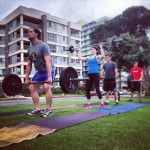
Yesterday’s workout was a combination of fifteen second efforts. Though the movements, too, were explosive in nature, the sheer lack of time to work during the training day resulted in a “built in” explosive element, if you will. This explosive training breeds true power, and true power is often the biggest glaring hole in fitness programs today.
Having power sounds like a good thing, but what does it really mean and why is it so critical?
Power from a psychics standpoint is simply work divided by time. In much of our training, the goal is often to do more work faster (i.e. maximize power output). But, why? First of all, work capacity in a very basic, measurable way is extremely valuable in life. Life rewards productivity. Thus, developing capacity to do more in less time has carry over in every way imaginable, from having more energy at work to being able to run faster in the forth quarter than your opponent.
Secondly, the dynamics of our metabolic engines look like a one way street. Think about our body’s metabolic pathways as having three gears or speeds. The phosphagen pathway is a burst of maximal effort (Think 10-15 seconds or less). That’s full throttle. The mid-range pathway is called the glycolytic pathway and it’s a higher intensity effort that can only be sustained from 10-15 seconds to just a couple minutes in length. And lastly, the oxidative pathway is our cruising speed. Even reading this sentence you are tapping into the oxidative pathway, and you can sustain this energy pathway forever.
The “one-way-street concept” says that the phosphagen (high power output) and the glycolytic (mid-range power output) pathways are not only effective in building capacity in both pathways, but they have the ability to positively contribute to oxidative output. It’s the reason that mid range power athletes can head out to a local 10K or half marathon and finish it respectfully. Though they probably wouldn’t win an endurance event, they could hold their own. The argument extends to say that though training the oxidative pathway (low power output) in effective at increasing performance within the context of oxidative efforts, it doesn’t have the ability to improve mid-range and higher power output performance. In actuality, focused oxidative training impedes higher power performance. Imagine a marathon runner attempting to perform a bodyweight back squat.
In other words, we train with speed and intensity because power is one of those things that “if you don’t use it, you lose it.” Plus, high power output training gets more bang for your buck. How much of your training includes heavy, short, high intensity efforts? If you’re missing out, you may want to hop on board even if your goals are more oxidative in nature.
Logan Gelbrich
——————–
Thursday’s Workout:
Complete 10 rounds:
-Power Clean
-Front Squat
-Push Press
-Back Squat
-Rack Jerk
-Rest 90 sec-
*Score is heaviest round and lightest round
